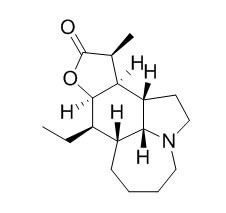Neostenine
Neostenine shows significant antitussive activity.
Inquire / Order:
manager@chemfaces.com
Technical Inquiries:
service@chemfaces.com
Tel:
+86-27-84237783
Fax:
+86-27-84254680
Address:
1 Building, No. 83, CheCheng Rd., Wuhan Economic and Technological Development Zone, Wuhan, Hubei 430056, PRC
Providing storage is as stated on the product vial and the vial is kept tightly sealed, the product can be stored for up to
24 months(2-8C).
Wherever possible, you should prepare and use solutions on the same day. However, if you need to make up stock solutions in advance, we recommend that you store the solution as aliquots in tightly sealed vials at -20C. Generally, these will be useable for up to two weeks. Before use, and prior to opening the vial we recommend that you allow your product to equilibrate to room temperature for at least 1 hour.
Need more advice on solubility, usage and handling? Please email to: service@chemfaces.com
The packaging of the product may have turned upside down during transportation, resulting in the natural compounds adhering to the neck or cap of the vial. take the vial out of its packaging and gently shake to let the compounds fall to the bottom of the vial. for liquid products, centrifuge at 200-500 RPM to gather the liquid at the bottom of the vial. try to avoid loss or contamination during handling.
Materials Today Communications2023, 37:107216
Methods Protoc.2024, 7(6):95.
J Agric Food Chem.2021, 69(11):3496-3510.
Molecules.2024, 29(16):3976.
Analytical Letters.2020, doi 10.1008
Front Microbiol.2019, 10:2806
Preprints2017, 2017120176
JLiquid Chromatography & Related Tech.2021, 10826076.
Molecules.2020, 25(7):1625.
VNU J of Science: Med.&Pharm. Sci.2023, 39(1):20-29.
Related and Featured Products
Planta Med. 2003 Oct;69(10):914-20.
Antitussive activity of Stemona alkaloids from Stemona tuberosa.[Pubmed:
14648394]
METHODS AND RESULTS:
Bioactivity-directed fractionation of the crude extract of Stemona tuberosa led to the isolation and characterization of four new stenine-type Stemona alkaloids, namely tuberostemonine J ( 2), tuberostemonine H ( 3), epi-bisdehydrotuberostemonine J ( 4) and Neostenine ( 5), together with the known neotuberostemonine ( 1). These five isolated alkaloids were examined for antitussive activity in guinea pig after cough induction by citric acid aerosol stimulation.
CONCLUSIONS:
In this report, we demonstrated, for the first time, that compounds 1 and 5 showed significant antitussive activities. Further study of the structure-activity relationship on these isolated alkaloids and two synthetic analogues revealed that the saturated tricyclic pyrrolo[3,2,1- jk] benzazepine nucleus is the primary key structure contributing to the antitussive activity and all cis configurations at the three ring junctions are the optimal structure for the antitussive activity of stenine-type Stemona alkaloids.
Planta Med. 2006 Feb;72(3):211-6.
Intestinal absorption of Stemona alkaloids in a Caco-2 cell model.[Pubmed:
16534724]
METHODS AND RESULTS:
The intestinal absorption of neotuberostemonine and Neostenine, two major bioactive alkaloids of the commonly used antitussive traditional Chinese medicine Stemona tuberosa Lour, was investigated using a Caco-2 monolayer model. Both alkaloids exhibited a high absorptive permeability which was higher for Neostenine [P(app(AB)) = 12.03 +/- 1.14 x 10 (-6) cm/s] than for neotuberostemonine [P(app(AB)) = 9.27 +/- 0.79 x 10 (-6) cm/s], indicating that they are likely to be well absorbed and orally active. Furthermore, both alkaloids were identified to be the substrates of P-glycoprotein and have a transport preference from the basolateral to apical direction with efflux ratios between 2 and 3.
CONCLUSIONS:
Cyclosporin A dose-dependently inhibited the secretory permeability of these alkaloids and abolished their active efflux transport.



